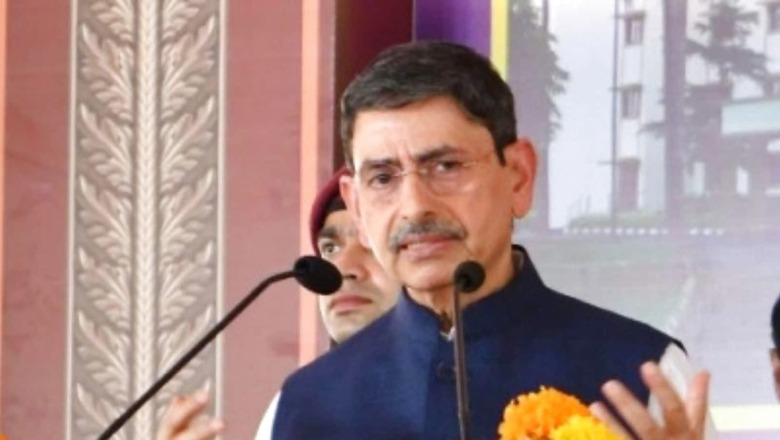
views
On 6 March 1969, West Bengal Governor Dharma Vira read out the customary address to the first joint session of the West Bengal legislature prepared by the council of ministers. However, he skipped two paragraphs that were critical of the Centre’s decision to dismiss Ajoy Mukherjee’s ministry on 21 November 1967 who was again appointed the Chief Minister on 25 February 1969.
As reported by the Tribune, “As the Governor skipped a part of the speech prepared by the State Cabinet, members shouted: ‘Read the full text.’ He ignored the interruptions and went on with the speech. Chief Minister Ajoy Mukherjee then stood up and told him he should read the speech as prepared by the Cabinet. After initially ignoring the remark, Mr Dharma Vira turned to him and said, ‘Ajoy Babu, I have already told you that I will not be able to read this portion’.”
On 9 January, Tamil Naidu Governor RN Ravi was forced to walk out of the Tamil Nadu Assembly after Tamil Nadu Chief Minister MK Stalin moved a resolution, saying only the customary speech the government has prepared for the first day of the House’s winter session will go on record. The Governor had reportedly made some addition to the speech and had omitted some points from it.
This might come as an unsavoury and rare sight for someone not acquainted with a history of the working of the state governments in the context of the role of Governors. However, for the well-versed, the tussle and the tension between the state government and the Governor is quite common and has resulted in many episodes of constitutional crises and bizarre turn of events on many occasions.
Working of Indian polity is marked by numerous instances which perplex the most astute observer of politics. But there are a few episodes that leave one baffled if one is not aware of the exact context. One such baffling event took place on 26 February 1998, when the Uttar Pradesh (UP) Assembly witnessed an extremely unusual sight. Seated on the left and right of the UP Assembly Speaker Kesari Nath Tripathi were two Chief Ministers. Kalyan Singh who was sacked by Governor Romesh Bhandari a few days ago was sitting on the right side of the speaker and Jagdambika Pal the newly sworn-in Chief Minister whose appointment was already held unconstitutional by the Allahabad High Court was sitting on the left.
The events that preceded this unusual visual were equally dramatic. Romesh Bhandari, the Governor of Uttar Pradesh, had on 21 February 1998, sworn-in Loktantrik Congress Party (LCP) leader Jagdambika Pal as the Chief Minister of Uttar Pradesh after dismissing Kalyan Singh government. Bhandari dismissed Singh’s government after the LCP withdrew its support given to the Kalyan Singh government.
In spite of Singh’s assurance that his government enjoyed a majority in the house, Pal was made the Chief Minister. Kalyan Singh moved the Allahabad High Court challenging the Governor’s decision. The court held the appointment of Pal unconstitutional and reinstated Singh as the Chief Minister. Following this in a special leave petition (SLP) filed by Kalyan Singh in the Supreme Court, the apex court ordered a composite floor test which Singh won.
This was a textbook case that raised important questions about the role of the Governor in Centre-state relations. However, this was not the first case when the role of the Governor came under the scanner. The history of independent India is replete with such instances.
Starting in 1952, when Madras Governor Sri Prakasa (a long-time Congressman) instead of inviting United Front led by the T Prakasam (which has won more seats than the Indian National Congress (INC)) to form the government, gave C Rajagopalachari of Indian National Congress (INC) a chance to form the government.
It was obvious that the Governor was working at the command of the Centre and was helpless to judiciously use his discretion. Sri Prakasa in an article published in the Indian Express on 1 October 1962, wrote: “Very often I have felt that it was being made increasingly difficult for a self-respecting person to accept the office of a Governor.”
Need for the post of governor
The Sarkaria Commission formed under the chairmanship of a retired judge of the Supreme Court, Justice Ranjit Singh, to examine the Centre-state relations while commenting on the need for the post of the Governor stated: “Governor whether acting with or without the advice of the Council of Ministers, plays a pivotal role in our constitutional system and in its working.”
The need for the post of Governor has been aptly summarised in this paragraph from the report: The tenure of the Governor, unlike that of the Chief Ministers does not depend on majority support in the Assembly. Chief Ministers change from time to time depending on their enjoyment of loss of such support. But the Governor continues irrespective of change of Ministries or even dissolution of the Assembly. The Governor continues even on the expiry of his five-year term till his successor takes over. Thus, the institution of the Governor assures continuity of the process of government. He fills the political vacuum as and when there is a breakdown of the constitutional machinery in the state. Even in the normal working of the system, there may be some situations under the Constitution where the advice of the Council of Ministers is not available to him for a short period.
An instance of such a situation would be when a ministry resigns and refuses to stay in office as caretaker till another ministry is formed or till President’s rule is imposed. During a short interregnum of this nature, the Governor would be within his power to carry on the executive affairs of the state through his subordinates, as the Constitution does not intend that there should be a break or paralysis of the executive government in such situations.
This concern for the “continuity of the process of government” in the states was of utmost concern to the framers of the Constitution. So, the position, role, and powers of the Governor were discussed in great detail in the Constituent Assembly.
In fact, initially, the majority of the members of the Constituent Assembly were in favor of an elected Governor. BN Rau suggested an indirect election by a system of proportional representation. Shubhankar Dam, Professor of Public Law and Governance at the University of Portsmouth School of Law, United Kingdom, in his insightful essay titled ‘Executive’ in ‘The Oxford Handbook of The Indian Constitution’ writes, “In effect, he (Rau) proposed a state version of presidential elections along with similar rules of impeachment. The Patel-led Provincial Constitution Committee disagreed. Indirect elections, the members said, were insufficiently representative. They favoured direct elections. ‘The dignity of the office’ demanded nothing less, Patel argued.”
According to Dam, in July 1947, the committee report on provincial constitutions was discussed in the Constituent Assembly and members widely endorsed the idea of directly elected Governors. However, when two years later the issue of appointment of Governors again came up before the Constituent Assembly it became evident that the drafting committee led by Dr BR Ambedkar had “little faith in the popular Governors”. Also, by then most of the members; who earlier had favored for elected Governor were now in favour of a Governor appointed by the President.
It was rightly thought and reasoned that an elected Governor would require vesting him with real executive power which in presence of an elected Chief Minister would cause unending conflict between the two. “Fear of gubernatorial intrusion agitated some members. Popularly elected Governors with authority to intervene in the everyday affairs of states may breed instability, they argued. Backed by popular mandate, a Governor could claim greater representative authority than the Chief Minister,” writes Dam.
Going through Constituent Assembly debates it becomes amply clear that the members attached much importance to this office but did not want to create duality and duplicity of power centres in the states. After much debate, it was settled that the Governor would be a presidential appointee, who will work as a link between the Centre and the states.
It is an uncontested fact that India’s federalism has a strong unitary feature. From emergency powers vested with the Central government to the existence of all Indian services, all give strength to this argument. So, in this context, the Governor by logical explanation was to be someone who could be controlled by the Centre. There was no ambiguity to this expectation. But perhaps what was expected was that in spite being a Centre’s appointee the Governor will bear true faith and allegiance to the Constitution before obliging his political masters.
But, sadly since Independence, the extremely dignified office of the Governor has been denigrated to a great level. LP Singh, who served as Governor of multiple states, writes in Soli Sorabjee’s edited book, The Governor, Sage or Saboteur’, that Governor’s office had undergone “devaluation and even debasement”. Indeed, the devaluation has gone to that level that they are merely seen as “agents of the central government”.
HM Seervai’s Constitutional Law of India is one of the most authoritative texts on the Indian Constitution. In this book, he reflects on the problem with the independent functioning of the Governors. He writes: As the President acts on the advice of his Ministry, it may be contended that if the Governor takes action contrary to the policy of the Union Ministry, he would risk being removed from his post as Governor, and therefore he is likely to follow the advice of the Union Ministry. It is submitted that a responsible Union Ministry would not advise, and would not be justified in advising, the removal of a Governor because, in the honest discharge of his duty, the Governor takes action which does not fall in line with the policy of the Union Ministry. The removal of the Governor under such circumstances would otherwise mean that the Union executive would effectively control the state executive, which is opposed to the basic scheme of our federal Constitution. Article 156(1) was designed to ensure that if the Governor was pursuing policies that were detrimental to the State or to India, the President would remove the Governor from his office and appoint another Governor. This power takes the place of an impeachment which clearly is a power to be exercised in rare and exceptional circumstances.
Respect for the Constitution requires acknowledging the basic values enshrined in it. There is no doubt that the Governor is a Central government appointee and remains in office at the latter’s pleasure. But this does not empower the Centre to treat a constitutional functionary like a dignified ‘orderly’. At the same time, those gracing this highly regarded office need to understand that they are not expected to be a saboteur, and not even a sage.
They just need to act true to their conscience and Constitution. That will take care of the dignity of their office.
The writer is a journalist and researcher based in Delhi. He has worked with The Indian Express, Firstpost, Governance Now, and Indic Collective. He writes on Law, Governance and Politics. The views expressed in this article are those of the author and do not represent the stand of this publication.
Read all the Latest Opinions here
















Comments
0 comment